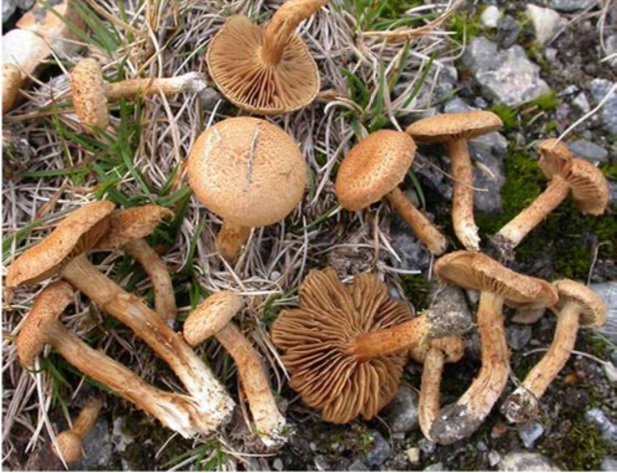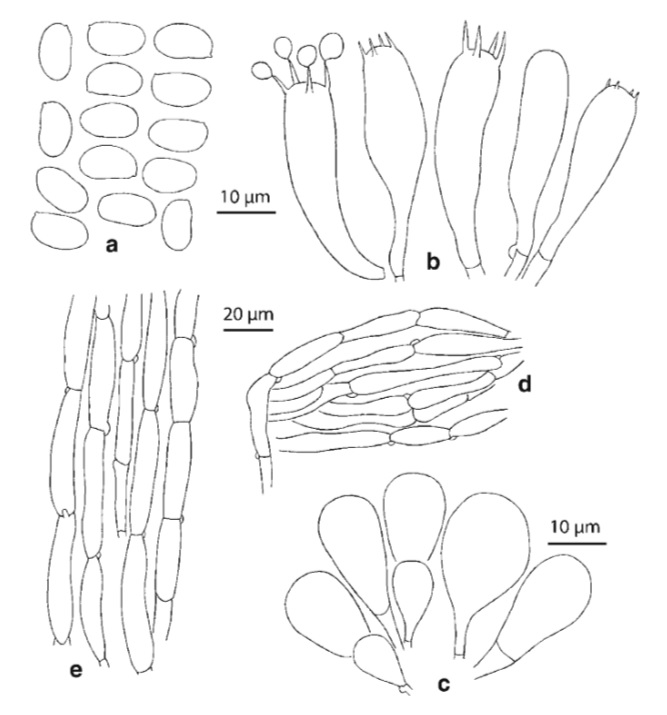Inocybe granulosa Jacobsson & E. Larss
MycoBank number: MB 812048 Facesoffungi number: FoF00989
Etymology: Refers to the granular small scaly appearance of the stipe and pileus.
Holotype: SWEDEN, Jämtland, Berg, close to Lake Storsjön, 4 km N Svenstavik, 1 September 2009, E. Larsson 138-09 (Herbarium GB). Pileus 10–32 mm diam., at first convex with an incurved margin, then expanded, when mature flat or frequently with somewhat depressed centre, not umbonate, at first pale yellowish, later becoming yellowish brown at least in the centre, covered by numerous small, floccose scales. The scales are often pointed and upraised at least in the centre, at first yellowish brown, sometimes but not always becoming dark brown with age. The scales often loosen and disappear at least partly in mature basidiomata. Lamellae normally distant, at first pale beige to yellowish, gradually rather dark greyish brown with a paler edge. Stipe 15–35 mm long, 2–4 (5) mm wide, equal or somewhat thicker towards the base, pale yellowish brown with a white base, with granular to floccose brownish scales similar to those on the cap. Veil beige sometimes forming a thin and evanescent annulus. Flesh pale, whitish without distinct smell, taste mild. Basidia clavate, 35–45× 8–11 μm, 4-spored, sometimes with brownish necropigments. Spores (8–)9–12×5–7(−7.5) μm, Q=1.4–1.8, mostly ellipsoid and slightly phaseoliform in profile. Cheilocystidia numerous, more or less septate with a broadly clavate to almost globose end cells, 12–24 μm broad, thin walled, some with brownish necropigments. Pleurocystidia absent. Clamp-connections present.
Habitat: On sandy roadsides or gravelly ground, often near mines or industrial sites, likely associated with Salix phyllicifolia but probably also with other Salix species. Likely favoured by calcareous ground.
Distribution: Found in upper boreal and subalpine zones in the western part of the provinces of Jämtland and Härjedalen, central Sweden and in adjacent parts of central Norway. Rather common and often abundant in its special habitat in central Scandinavia but so far not known outside this area. Material examined: SWEDEN, Jämtland, Åre, Handöl, sandy road-side with Salix, 10 August 1984, S. Jacobsson 84030 (GB); Jämtland, Berg, N Svenstavik, resting-place, among Salix phyllicifolia, 1 September 2009, E. Larssson 138-09 (GB, holotype) (Isotypus TUR-A); the same locality 26 August 2011, S. Jacobsson 11007 (GB); Jämtland, Åre, Undersåker, Nulltjärnsgården, road-side with Salix, 27 August 2011, S. Jacobsson 11008 (GB); Härjedalen, Tännäs, Bruksvallarna, roadside with Salix phyllicifolia 2 July 2012, S. Jacobsson 12002 (GB). NORWAY, Hedmark, Folldal, on clinkers close to the mine, 23 August 2012, S. Jacobsson 12016 (GB); Oppdal, Dovre, Hjerkinn, roadside with Salix phyllicifolia, 20 August 2012, S. Jacobsson 12017 (GB).
Notes: Members of subgenus Mallocybe frequently occur in boreal, subalpine and arctic/alpine regions (Kühner 1988; Cripps et al. 2010). Several of these species may have more or less distinct scales on the pileus surface and some of them may possibly be mistaken for Inocybe granulosa. The most similar species in the literature is I. squarrosoannulata (originally described as I. dulcamara f. squamosoannulata by Favre 1955) encountered in alpine environments growing with dwarf Salix. It is depicted with distinct scales both on the pileus surface and the stipe (Bon 1997; Ferrari 2006), but the scales are coarser than in I. granulosa and arranged in garlands, somewhat similar to I. terrigena (Fr.) Kuyper. Comparison of ITS sequence data of the holotype show that I, squarrosoannulata and I. granulosa are distinct species. Another species about the same size and colour as I. granulosa and with similar habitats and ecology is I. malenconii Heim. However, the pileus is more finely scaly and the scales are absent or rare on the stipe. In micromorphology I. malenconii is easily separated from I. granulosa by having a narrowly cylindrical spore shape, more reminiscent of those of I. lacera (Fr.) P. Kumm. Inocybe malenconii was described from France (Heim 1931) and is widely distributed. It has been recorded several times in central Sweden and the Nordic countries, often found along roadsides (Jacobsson and Larsson 2012). Inocybe granulosa is readily identified in the field and commonly encountered in a restricted part of central Scandinavia, but so far not known outside this region. Despite similarity in macro-morphology with I. malenconii and I. squarrosoannulata the phylogenetic analysis indicate I. granulosa to be more closely related to I. agardhii (Lund) P.D. Orton, I. substraminipes Kűhn. and I. fulvipes Kűhn., all growing associated with Salix.



